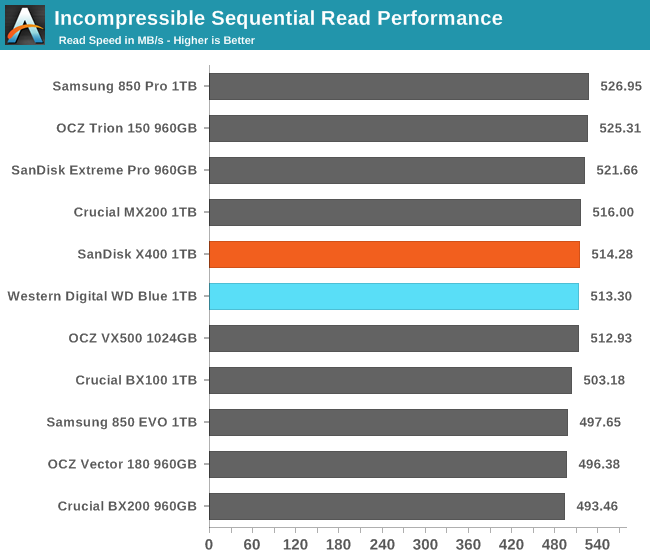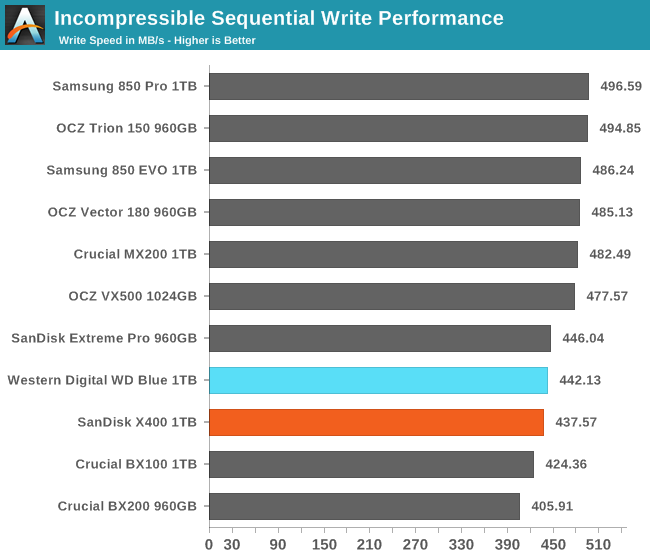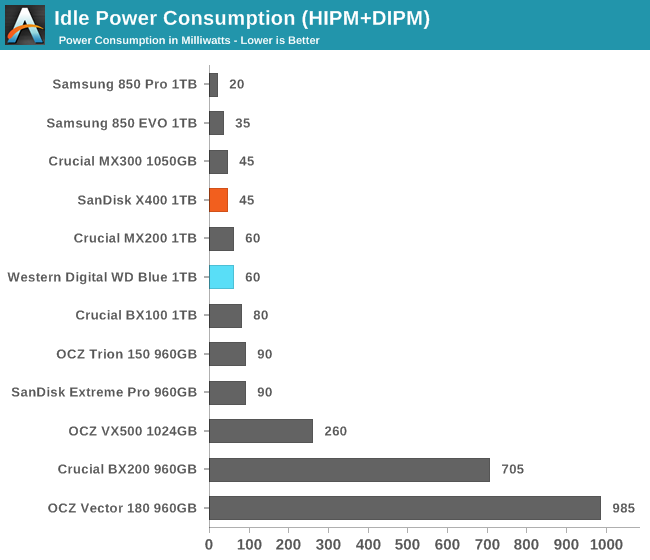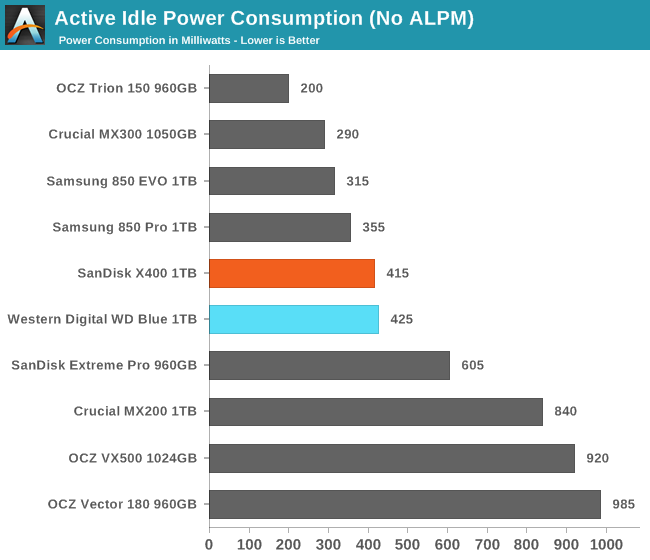The Western Digital Blue (1TB) SSD Review: WD Returns to SSDs
by Billy Tallis on October 11, 2016 8:00 AM EST- Posted in
- SSDs
- Storage
- Western Digital
- SanDisk
ATTO
ATTO's Disk Benchmark is a quick and easy freeware tool to measure drive performance across various transfer sizes.
 |
|||||||||
The WD Blue shows slightly better write speeds on the ATTO test than the SanDisk X400, but both fade a bit in read speed toward the end of the test.
AS-SSD
AS-SSD is another quick and free benchmark tool. It uses incompressible data for all of its tests, making it an easy way to keep an eye on which drives are relying on transparent data compression. The short duration of the test makes it a decent indicator of peak drive performance.


The AS-SSD test seldom shows large differences in performance, and the WD Blue performs almost identically to the X400. The write speed is still a bit on the low side.
Idle Power Consumption
Since the ATSB tests based on real-world usage cut idle times short to 25ms, their power consumption scores paint an inaccurate picture of the relative suitability of drives for mobile use. During real-world client use, a solid state drive will spend far more time idle than actively processing commands. Our testbed doesn't support the deepest DevSlp power saving mode that SATA drives can implement, but we can measure the power usage in the intermediate slumber state where both the host and device ends of the SATA link enter a low-power state and the drive is free to engage its internal power savings measures.
We also report the drive's idle power consumption while the SATA link is active and not in any power saving state. Drives are required to be able to wake from the slumber state in under 10 milliseconds, but that still leaves plenty of room for them to add latency to a burst of I/O. Because of this, many desktops default to either not using SATA Aggressive Link Power Management (ALPM) at all or to only enable it partially without making use of the device-initiated power management (DIPM) capability. Additionally, SATA Hot-Swap is incompatible with the use of DIPM, so our SSD testbed usually has DIPM turned off during performance testing.


The WD Blue uses a few milliwatts more at idle than the X400. In the slumber state this is not a problem and the WD Blue's power draw is about average. The active idle power draw is a bit on the high side given that the MX300 draws about two thirds what the WD Blue draws when both drives use the same controller and DRAM.










75 Comments
View All Comments
TheinsanegamerN - Tuesday, October 11, 2016 - link
it's an interesting drive, but why buy these when the likes of the mushkin reactor are $60 cheaper for the 1TB varient? sata III drives have peaked performance wise.OTOH, cant wait to see what the WD black SSDs look like. 4TB? M.2 PCIE?
dave_the_nerd - Tuesday, October 11, 2016 - link
The Reactor 1TB was a clone of the BX100... which outperformed the WD Blue in a lot of tests here. Getting harder to find them though.Hopefully the street price of this will be more in-line with the rest of the market, price/performance wise.
TheinsanegamerN - Tuesday, October 11, 2016 - link
the only thing this WD drive does better is write endurance. 400TB, or even 320TB for the sandisk version, is a heck of a lot better then the 144TB of the 1TB reactor drive.ammacdo - Tuesday, October 11, 2016 - link
The thing I like most about this review is seeing how well my BX100 still holds up, and I paid the same MSRP this one is going for over a year ago.paulgj - Monday, October 31, 2016 - link
I agree, I bought half a dozen BX100's when they went on sale. Excellent MLC SSDs.Bullwinkle J Moose - Tuesday, October 11, 2016 - link
It depends on the consistency of performance and not the peakThe concern I have is Sandisk consistency of performance which cannot be checked using a single test drive
I have 3 of the Sandisk Extreme Pro thumbdrives that are Windows to Go compatible as they are "Fixed Disks"
One of them is completely unusable after a week, one is so-so and one is very good (performance wise)
The only thing that will return the speed to "Like-New" condition is using Killdisk over the entire drive
The CrapCleaner Drive wipe utility does not return full performance, and the new Defraggler SSD Optimizer does not return full performance
I have not found any method other than Killdisk to temporarily regain full disk performance
Of course, not having Trim or Garbage collection exacerbates the problem which then accelerates the thermal throttling issue
Mushkin also has a bad rep for thermal issues on their Win2Go compatible thumbdrives
The new Corsair GTX beats them all hands down for Windows to go and since my test machine is an older Sandy Bridge for XP compatability, the corsair is actually faster on the USB3 port than my Samsung 850 Pro is on the SATA2 ports
I hope Anandtech can address consistency between identical drives at some point
Bullwinkle J Moose - Tuesday, October 11, 2016 - link
Corsair GTX Thumb drives seem VERY Consistent between drives as wellWwhat - Sunday, October 30, 2016 - link
You seem to be a pretty unique case and not an average user in any way.But it's still an interesting comment I feel. Or I should say 'because of that' rather than 'still'.
Bulat Ziganshin - Saturday, October 15, 2016 - link
they can't build Black from air. sandisk best ssd is extreme pro, so Black will be updated version of itnathanddrews - Tuesday, October 11, 2016 - link
Does this WD SSD come with software to clone/shrink your existing drive to the new SSD? I have an older SiliconEdge Blue 64GB SSD (still working well) and WD offers a utility on their website to do just that, but only if there is a WD drive attached to the machine. I assume this utility would work with this SSD? Not sure if you image your test drives using different tools or what.Samsung has another great utility that comes with a slick SATA-to-USB 3.0 dongle (free in the box) that will clone/shrink any drive to a target Samsung SSD. They go above and beyond the capabilities of Windows volume shrink by a lot.